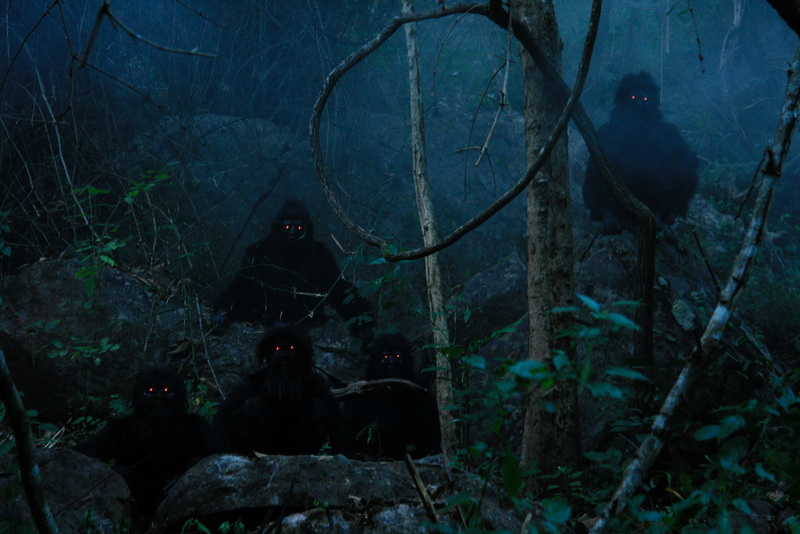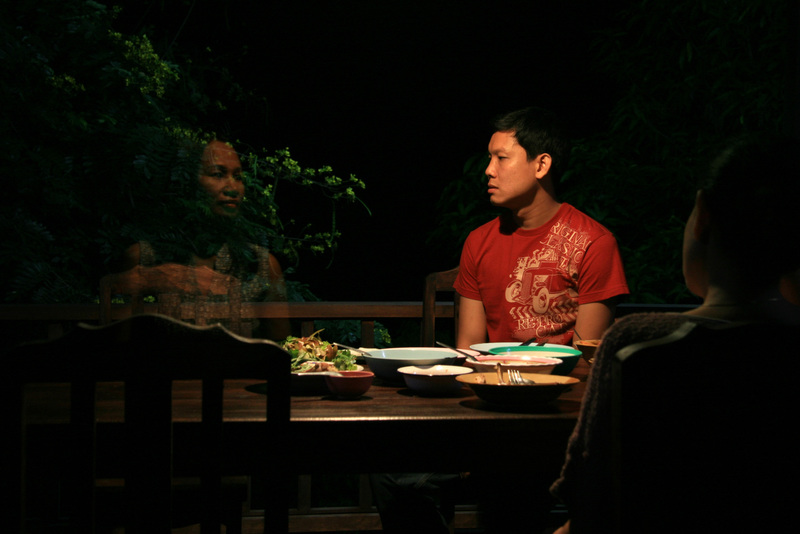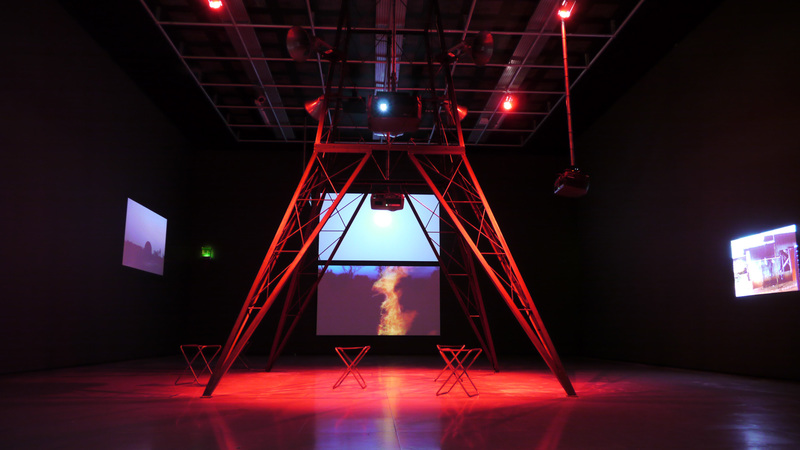People
Recording the Mekong: An Interview with Apichatpong Weerasethakul


Artist and filmmaker Apichatpong Weerasethakul’s Cactus River (Khong Lang Nam) (2012) is a short experimental film starring his long-time collaborator Jenjira Pongpas. The title of this work is a contradiction evoking a river full of desert plants, but also a very real future for the Mekong due to an abundance of new upstream dam constructions. As downstream water levels continue to fall, Jenjira marries a retired American soldier and changes her name to Nach, which means “water.” Visiting Nach and her new life in Isaan, the filmmaker notes that both she and the Mekong are changing, along with the memories of who and what they once were. The following interview marks ten years of Cactus River and was conducted amid a global pandemic. Looking back, Apichatpong considers the changes in our relationships to the landscape that have been ushered in by this new era.


Many of your films have been set in Isaan, Thailand’s north-eastern region bordered by the Mekong River and Laos, including Cactus River (Khong Lang Nam) from 2012. The ten-minute film reflects the importance of the Mekong River as a geographical, political, economic, and spiritual part of everyday life for people in this region. Can you speak about your interest in Isaan and its landscape, and how your particular process of filmmaking incorporates the landscape as something embedded in the experience of that region?
I grew up in Isaan but I was not born there. My parents were from the central part of the country but moved to Khon Kaen to practice medicine. There was a certain distance between them and the locals, because the regional dialect and culture are different where they were from. I felt a bit isolated, like I was in a bubble, growing up around the hospital. I also think that because the education system in Thailand is dictated from its center, what we learn about our history is sanitized and Bangkok-centric, so I felt strange growing up in Isaan. I sometimes felt like I was an outsider.
Once I started making movies it was liberating to find out more about the place. I started to travel around the region, document and learn more. I came to connect with people and their memory of the landscape. I'm a pretty shy person so I was working with people who were really close to me at first. Over the years, the crewmembers also became like family. One of them is Nach, the star of Cactus River. I repeatedly visited her in her hometown of Nong Khai, a town between Thailand and Laos where the Mekong itself is the border. I continued to travel with her to different cities along the Mekong.
My interest in filming Isaan began with Uncle Boonmee Who Can Recall His Past Lives (2010) and Primitive (2009), some ten years ago. I was on the road to look for Mr. Boonmee’s sons and relatives from a story in a booklet I had received from a monk. In the process, we discovered so many stories. Eventually Boonmee’s mission became less interesting to me, and my project became more concerned with the political memories and hardships of the people in Isaan.
The area alongside the Mekong is difficult to cultivate, and with the suppression from the center, a lot of people in the north move to live and work somewhere else—in Bangkok or in other countries. As I started to know these stories, I began to link peoples’ lives with the landscape and how they’re dependent on the river and the land, in particular the environmental cycle: the rainy seasons, the monsoon seasons, and the dry seasons.
Over the years, while visiting Nach, myself and others have observed the Mekong’s water level fluctuate. I’ve also observed protests and how communities are communicating with the Mekong River Commission (MRC), a partnership between Thailand, Laos, Cambodia, and Vietnam that works to sustainably manage the resources of and around the Mekong. The construction of the dams upstream in Laos and China affects the people downstream in Thailand and Cambodia. This was my interest, but I’m not an activist, so I didn’t think that the film [Cactus River] would change anything—and that’s not its aim. My aim is to look at and record how the Mekong changes the area, and how those changes then affect the people there.


The region is spectacular because people are so mutually entangled with the landscape and watersheds. When a dam upstream disrupts the flow downstream, patterns of daily business are affected.
Nach and her husband Frank, who you also see in the film, are actually not so dependent on the Mekong for their livelihood but its environmental changes affect their life—for example, the unpredictability of the flooding made them decide to live in a house on higher ground. For me, the changing river is more symbolic. It separates us from Laos. People along the river used to be like family, and crossing was simple and common—with the political instability that followed the collapse of the Laos Kingdom, and as the river changed, people migrated through the Mekong to come to Thailand. Now the law forbids this movement. It’s like a border not only for daily life, but also political memory. The river now breaks apart families but before it used to be a common place.
My dad died in 2003 and we traditionally cremated him and scattered his ashes in the Mekong River, actually not far from Nach’s home. He lives there now and he kind of became part of the water and the seasons. People are also siphoning the river’s sand bed for the construction of new buildings, so I like to think that my father has become part of the structures around the Mekong too.

I’m curious about the use of sound in Cactus River. A majority of the sound is wind hitting the microphone but it’s so distorted that it could also be the sound of rushing water, the streams we were just talking about. It’s what carries us through the work and allows us to have a kind of symbolic transportation along the Mekong.
I was attracted by the force of the water and the way that the Mekong current is really strong. I wanted to reflect this in the film. I structured the whole work around the wind hitting the microphone and its intensity, like a wave coming and going that affects people. I highlight the recording apparatus, its sensitivity. Typically in filmmaking you’re taught to record sound and every word of dialogue very clearly. You don't want to record the wind hitting the microphone, which is considered defective, but I enjoyed it. I love the sound of this error, all this “ppppppp” of the wind. It's almost like the ear is testing the place and you’re testing the limitation of the equipment.
At the very end of the film you present a still image. It’s the only still and color image. We see Nach looking out and pointing to the Mekong, almost like a tourist snapshot. Why conclude the work like this?
I'm not sure what I was thinking at the time! Many times, I have no reason for such choices, but maybe one thing that I wanted to do was to remember that moment. That image is from my trip with Nach and the film crew. We were traveling along the Mekong before we started shooting the film. She’s probably explaining something to us about the river’s edge. Most of my information about the Mekong in this region comes from her because, as I mentioned, I grew up in a bubble and she was the one who introduced me to her world. It's quite important for me. The stillness and color could signify some kind of alternative reality, a marker away from the speed, and the black-and-white parts of the film.
Is there a part of the film that continues to impress you, looking back ten years now?
I think a lot about one of the last shots, the one with the skateboarder [moving along the riverfront]. It was really out of the blue. I value when something spontaneously happens in the filmmaking process. Skateboarding is such a beautiful activity. This guy has all of this joy and energy. It’s an elegant contrast to all of these political issues around the Mekong; life goes on and it can thrive somehow.

We typically see skateboarders gliding by very quickly but here you slow the shot down and we are allowed to relax and take in the image. This has been a difficult year where many of us were forced to slow down. Is there any way you’ve appreciated this shift in time? Has this change made you think differently about your immediate environment?
I'm thinking about lockdown time and being in one place, which allows you to observe small changes. I came to appreciate the seasons here more. We don't have so many seasons, it's humid and hot all the time, but there are subtle differences. I am sure Covid-19 has made us appreciate not only the cycle of the seasons but also more intimate daily relationships with people, animals, and insects.
I’m looking outside my window now. I’m seeing this one mountain and I realize I haven't seen it for a while. In February, March, and April, there's a lot of dust and smoke due to farmers burning the fields. The mountain was obscured by the smoke, but now I appreciate that I can see it again.







